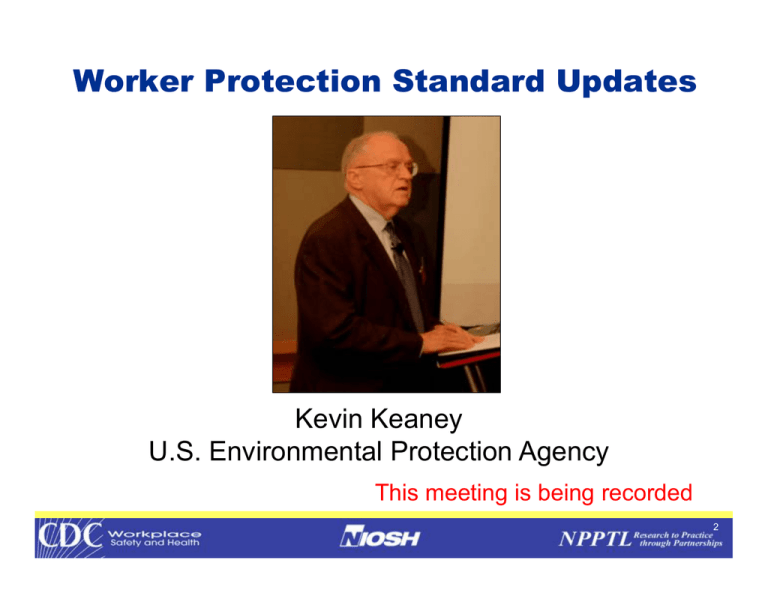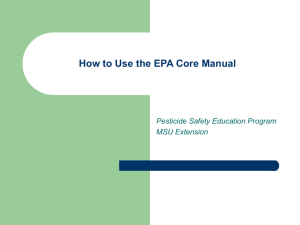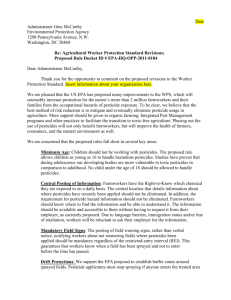Worker Protection Standard Updates Kevin Keaney U.S. Environmental Protection Agency
advertisement

Worker Protection Standard Updates Kevin Keaney U.S. Environmental Protection Agency This meeting is being recorded 2 40 CFR Part 170: Revisions to EPA's Agricultural Worker Protection Regulation Background on EPA’s Planned Regulation Revisions Key Pesticide Worker Safety Program Goals Minimize pesticide exposure to occupational pesticide users and agricultural field workers Protect human health and the environment by ensuring the competency of pesticide applicators 4 Pesticide worker safety program goals are achieved through: Implementing two related pesticide worker safety regulations The Agricultural Worker Protection Rule (40 CFR Part 170) Pesticide Applicator Certification Rule (40 CFR Part 171) Guidance and training for state regulators Developing program support materials and resources (training materials, exams, etc.) Multi-lingual, multi-media outreach to populations with environmental justice issues Partnership with a broad range of government and non government entities 5 Summary of Current Requirements 6 Pesticide safety training and safety information Restrictions during applications Restricted-entry intervals (REI) Personal protective equipment (PPE) Notice of applications and posting of treated areas Decontamination supplies Emergency assistance Employer record keeping and information about applications Access to labeling and site specific information for handlers Rationale for Revisions 7 Changes under consideration build on the foundations of the existing requirements with targeted improvements necessary to achieve FIFRA’s protective mandates There are significant gaps in protection resulting in preventable adverse health effects for workers Lack of clarity in current regulations increases confusion for businesses and makes enforcement difficult for States Overview of Proposals Under Consideration Improve effectiveness of worker and handler training: Improve protections to workers from Restricted Entry Intervals (REIs): Ag employer provide notifications to workers when directing early entry (during REI) to a treated area Oral and written notifications Limit duration of early entry during agricultural emergency Keep records of workers in a treated area during the REI. Post warning signs at treated area for pesticide application with a certain REI. Improve content of warning signs posted at treated areas during REI Improve protections for workers during pesticide applications: 8 Reduce retraining interval Expand training contents Eliminate grace period Improved worker trainer competency Establish training recordkeeping Requirement for application restrictions for farms/forests similar to those in place for nurseries and greenhouses Overview of Proposals Under Consideration Improve hazard communication protections: Improve effectiveness of safety poster: Expand poster content to match expanded training points Add requirement for poster at decontamination supply location Improve protections for Crop Advisor employees: Require PPE for entry during REI Provide decontamination supplies Improve effectiveness of decontamination supplies: Improve eye flush water supply requirements for workers and handlers Improve effectiveness of emergency information: 9 Expanded information on application and hazard to be available Specify when application information must be recorded and retention period. Require handler employer of commercial applicators to notify agricultural employer of any changes in application, within specified time period. Specify information to be provided and time allowed to provide it Overview of Proposals Under Consideration Protect children: Establish minimum age for worker entry under the REI Improve handler application restrictions: Require handlers to cease application if workers enter restricted area around treated area. Improve effectiveness of Personal Protective Equipment (PPE): Clarify requirements for closed systems to permit exception for PPE. Require maintenance of enclosed cabs and closed systems Require medical monitoring, fit testing, and training for handlers who use respirators. 10 Protect children: Establish minimum age for handlers Pesticide Safety Training: A Healthy Partnership . 52 member organizations Serving 340 communities Fifteen year history of partnering with EPA Office of Pesticide Programs Committed to improving the quality of life for migrant and seasonal farmworkers and their families. Provided pesticide safety training to 500,000 farmworkers and farmworker families Three programs, using storytelling, to focus on pesticide safety Americorps SAFE Project Serving America’s Farmworkers Everywhere Partnership with EPA, AmeriCorps and AFOP 28 members-unique background 10 sites in 9 states SAFE Project Serving Worker protection safety training is primary responsibility America’s Farmworkers Everywhere Thousands of farmworkers trained on pesticide worker safety Storyboard tool for safety training Project HOPE Health Outreach through Pesticide Education Strengths of HOPE = community based Project HOPE 23 sites in 22 States 80 Certified Trainersculturally sensitive Trained 19,000 farmworkers Strengths of HOPE trainers AFOP’s Pesticide Safety Training Model Low-literacy level Interactive Demonstrations Audience Participation Story Telling Sharing personal experience Language component Project LEAF Limiting Exposures Around Families EPA recognized need - studies and health factors for kids Project LEAF Limiting Exposures Around Families Meet the LEAF Family Marcos, Isabella, Dona Cecilia, Ruben, Leity, Baby Anita Story Telling = Action Items for Farmworker Families Behavior Change Recommendations DISCLAIMER The findings and conclusions in this presentation have not been formally disseminated by the National Institute for Occupational Safety and Health and should not be construed to represent any agency determination or policy. This meeting is being recorded 27




